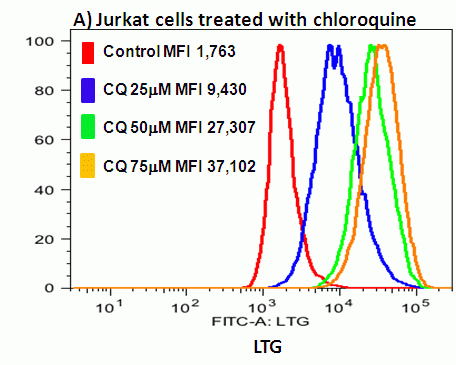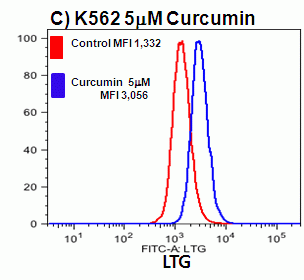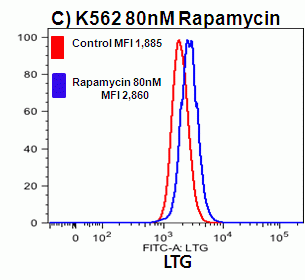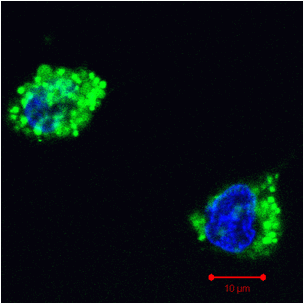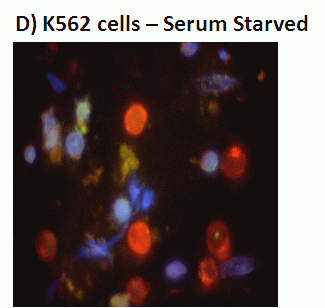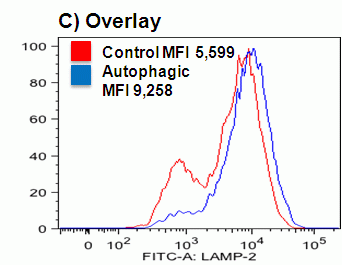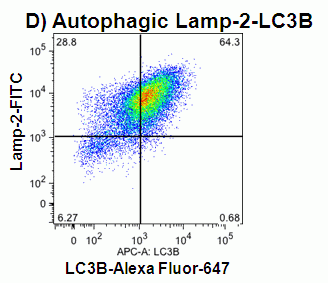Role of lysosomes in autophagy
There are numerous methods of inducing autophagy including serum and total nutrient starvation and rapamycin which both inhibit mTOR signalling. Chloroquine interestingly induces the formation of autophagosomes but blocks the formation of autophagolysosomes and hence ultimately is an inhibitor of autophagy. The ER-ATPase inhibitor, Thapsigargin has also been reported to induce autophagy of the ER. Chaperone Mediated Autophagy or CMA in which cytosolic proteins are sequestered to lysosomes via a protein chaperone e.g. cytosolic protein hsc70 and are then degraded after binding to lysosomal membrane protein, LAMP-2.
Acridine Orange (AO) which is commonly employed to measure DNA and RNA levels within cells can also be employed to measure the level of acidic granule formation within cells undergoing autophagy, which show an increase in the red signal.
The current methods of determining the presence of autophagy is based on the fact the microtubule protein, LC3 normally present in the cytoplasm, but during the autophagic process is cleaved and lipidated with the phospholipid, phosphatidyl-ethanolamine (PE) to form LC3B in autophagosomes, see figure. After fusion of the autophagosome with lysosomes, to form the single membrane bound, autolysosome the the internal LC3B is reduced. The LC3B can be tagged with GFP (fluorescence is acid sensitive) and RFP (acid resistant) and imaged by fluorescence microscopy or analyzed flow cytometrically. The LC3B levels can also be measured by the use of polyclonal LC3B antibody tagged in this case with Alexa Fluor 647, which can then be analyses flow cytometrically.
Lysosome tracking in autophagy
Lysosomes fuse with double membrane bound autophagosomes to form single membrane structures autolysosomes during the autophagic process. This fusion allows the contents of the autophagosome to be digested by lysosomal enzymes such as hydralases. The autophagic process requires the generation of a supply of lysosomes as more than one lysosomes fuses with a single autophagosome. This increase in lysosome numbers during the autophagic process can be measured flow cytometrically by the employed of LysoTracker dyes from Invitrogen.
Here we have employed LysoTracker Green (LTG) and Red (LTR) to measure the autophagic process flow cytometrically after induction by chloroquine and rapamycin. The signals are larger with chloroquine as this anti-malarial drug causes an inhibition of the fusion process between autophagosomes and lysosomes. This results in a build up of lysosomes resulting in a larger detectable signal, in a simi liar process to that employed by the use of Golgi stop reagent such as monensin and Breveldin A, in the flow cytometric detection of intracellular cytokines, see figure.
The sensitivity of LTG or LTR to detect autophagy is demonstrated by the induction of autophagy by rapamycin which only induces autophagy but does not cause an inhibition of the autophagic process and thus has a lower LTG signal but which is still significantly above that detected in resting cells, see figure.
The indian spice, tumeric or curcumin is a single compound used in indian cookery has numerous significant biological properties one of which is to induce autophagy as well as apoptosis. This can be purchased from Sigma chemicals or any high street supermarket. Turmeric causes an increase in lysosomes that can also be measured flow cytometrically by the use of LTG, see figure. LTG reveals that curcumin induces a dose response in Jurkat T-cells and K562 cell lines.
CMA - Chaperone Mediated Autophagy
The main lysosome receptor for the clearance of cytosolic proteins via chaperone hsc70 is LAMP-2 which is up-regulated by de novo synthesis during the autophagic process, see figure. This up-regulation can be measured flow cytometrically in conjunction with the detection of the main autophagic marker, LC3B, see figure. Image analysis of such cells stained with anti-LAMP-2-FITC and anti-LC3B-TRITC clearly shows 3 populations, LC3B autophagosomes labelled red, LAMP-2 lysosomes labelled green and LC3B-LAMP-2 double positive autolysosomes labelled yellow, see figure.
Publications
S Chikte, N Panchal, G Warnes. Use of LysoTracker dyes: A flow cytometric study of autophagy. Cytometry A (epub) DOI: 10.1002/cyto.a.22316 July 2013.
A Want, S Cohen, G Warnes. Cell suicide is not painless for the flow cytometrist: New Assays to measure cell death. Meeting report of the flow cytometry Euroscicon meeting in UK 7th November 2012. Kindle Edition, Amazon, Honnao Publishing, June 2013.
N Panchal, S Chikte, BR Wilbourn, UC Meier, G Warnes. Flow cytometric measurement of cell organelle autophagy. Autophagy - A Double-Edged Sword - Cell Survival or Death? Ed, Y. Bailly. InTech Open Access Publisher ISBN 978-953-51-1062-0, April 2013.
G. Warnes, S. Chitke and N. Panchal. A Flow Cytometric Study of Lysosome Tracking and LC3B Signals in Autophagy. Cytometry abstract CYTO2012, 2012.

